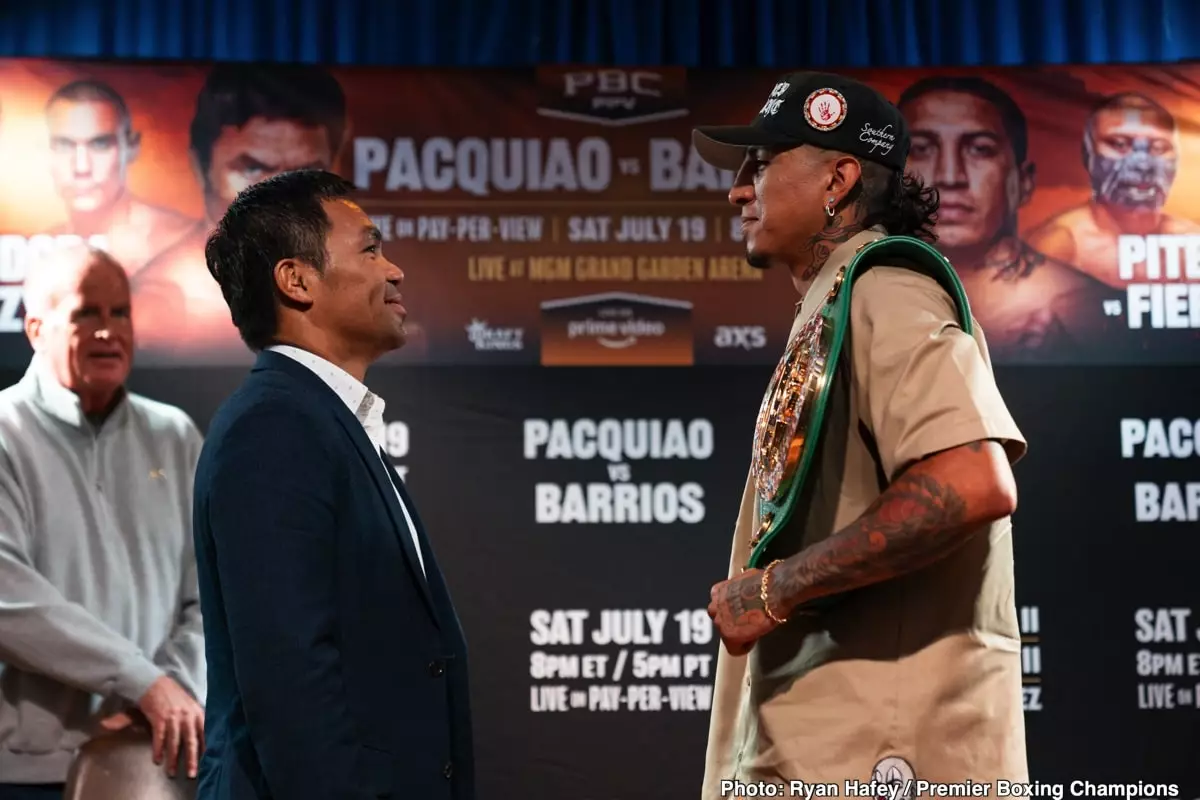As the boxing world turns its eyes toward Las Vegas for the highly anticipated matchup between Mario Barrios and Manny Pacquiao on July 19, the stage is set not just for a fight, but for a clash of legacies. Barrios, the reigning WBC welterweight champion, is preparing to confront one of the greatest fighters in the history of the sport, a man known for his lightning speed and relentless spirit. This bout could mark a pivotal moment in Barrios’ career, one that will define his standing in the boxing elite as he inherits the immense shadow of Pacquiao’s illustrious career.
The Size Difference: A Game-Changer?
At the press conference, one of the first things that jumped out to those in attendance was the considerable size difference between Barrios and Pacquiao. Standing at a taller frame, Barrios appears to possess not only the height but also the reach advantage. As fight analysts and fans alike speculate about the implications of this physical disparity, it’s important to consider how size and weight may play critical roles in determining the fight’s outcome. Historically, taller fighters have utilized their range to keep opponents at bay, but Pacquiao’s speed has often neutralized such advantages. This intriguing dynamic adds an extra layer of suspense to their clash.
Manny Pacquiao: The Comeback Kid
Despite being 46 years old and coming off a four-year hiatus from professional boxing, Pacquiao exudes an air of confidence that is both inspiring and concerning. When he states he “misses the passion” of boxing, fans can’t help but feel a mix of excitement and trepidation. With Pacquiao, it’s never been just about the dollars; his legacy has always involved a genuine love for the sport. The question looms: can he genuinely find that rhythm again, or is he destined to face the consequences of age?
Barrios seems determined to capitalize on any signs of decline. His admiration for Pacquiao’s historic matches against Juan Manuel Marquez reveals a deep understanding of what it takes to box at the highest levels. By aiming to emulate Marquez’s shocking knockout of Pacquiao, Barrios makes it evident that he intends to treat this fight as a last-man-standing episode—no prisoners taken. This cavalier approach brings both excitement and a hint of danger—not just for Pacquiao, but for Barrios, who arguably has more on the line.
Fan Expectations and the Sports Narrative
As fervent fans anticipate the fight, two divergent narratives are bubbling to the surface. On one hand, a significant portion of the crowd is rooting for the nostalgia of Pacquiao’s glory days, eager to see their hero defy age and reclaim the spotlight. On the other, there are skeptics who fear that this comeback could transpire into a cataclysmic event should Barrios execute a knockout that echoes Marquez’s unforgettable defeat of Pacquiao. The potential for tragedy adds a palpable tension to the buildup, making this bout not merely a competition but a potential turning point in both men’s careers.
Barrios himself recognizes the stakes involved, emphasizing that he is not merely there to play it safe. His statement, “It’s kill or be killed in there,” resonates with a mantra embraced by many fighters who aspire to make their mark on the sport. While this outlook showcases his relentless determination, it raises the question of whether such an aggressive mindset could lead him into pitfalls against a seasoned counterpuncher like Pacquiao.
In the heart of the Mandalay Bay, amid the flashing lights and clamor of the audience, Mario Barrios and Manny Pacquiao are on a collision course that promises to leave a mark on boxing history. With youth facing experience and resilience standing tall against nostalgia, both fighters have reputations—and pride—to defend. While Barrios aims to carve his niche with an emphatic victory, Pacquiao chases the echoes of his illustrious past, raising questions about legacy, time, and fate. The fight is just around the corner, and in the world of boxing, anything can happen—setting the stage for a night that may very well reshape the future.

